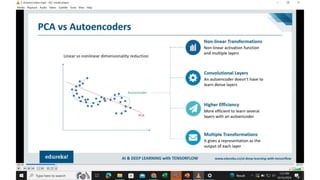AUTO ENCODERS (Deep Learning fundamentals)
- 2. Autoencoders ● Supervised learning uses explicit labels/correct output in order to train a network. ○ E.g., classification of images. ● Unsupervised learning relies on data only. ○ E.g., CBOW and skip-gram word embeddings: the output is determined implicitly from word order in the input data. ○ Key point is to produce a useful embedding of words. ○ The embedding encodes structure such as word similarity and some relationships. ○ Still need to define a loss – this is an implicit supervision.
- 3. Autoencoders ●Autoencoders are designed to reproduce their input, especially for images. ○Key point is to reproduce the input from a learned encoding.
- 4. Autoencoders ●Compare PCA/SVD ○PCA takes a collection of vectors (images) and produces a usually smaller set of vectors that can be used to approximate the input vectors via linear combination. ○Very efficient for certain applications. ○Fourier and wavelet compression is similar. ●Neural network autoencoders ○Can learn nonlinear dependencies ○Can use convolutional layers ○Can use transfer learning
- 5. Autoencoders: structure ● Encoder: compress input into a latent-space of usually smaller dimension. h = f(x) ● Decoder: reconstruct input from the latent space. r = g(f(x)) with r as close to x as possible
- 6. Autoencoders: applications ● Denoising: input clean image + noise and train to reproduce the clean image.
- 7. Autoencoders: Applications ● Image colorization: input black and white and train to produce color images
- 8. Autoencoders: Applications ● Watermark removal
- 9. Properties of Autoencoders ●Data-specific: Autoencoders are only able to compress data similar to what they have been trained on. ●Lossy: The decompressed outputs will be degraded compared to the original inputs. ●Learned automatically from examples: It is easy to train specialized instances of the algorithm that will perform well on a specific type of input.
- 10. Capacity ●As with other NNs, overfitting is a problem when capacity is too large for the data. ●Autoencoders address this through some combination of: ○Bottleneck layer – fewer degrees of freedom than in possible outputs. ○Training to denoise. ○Sparsity through regularization. ○Contractive penalty.
- 11. Bottleneck layer (undercomplete) ● Suppose input images are nxn and the latent space is m < nxn. ● Then the latent space is not sufficient to reproduce all images. ● Needs to learn an encoding that captures the important features in training data, sufficient for approximate reconstruction.
- 12. Simple bottleneck layer in Keras ○ input_img = Input(shape=(784,)) ○ encoding_dim = 32 ○ encoded = Dense(encoding_dim, activation='relu')(input_img) ○ decoded = Dense(784, activation='sigmoid')(encoded) ○ autoencoder = Model(input_img, decoded) ● Maps 28x28 images into a 32 dimensional vector. ● Can also use more layers and/or convolutions.
- 13. Denoising autoencoders ● Basic autoencoder trains to minimize the loss between x and the reconstruction g(f(x)). ● Denoising autoencoders train to minimize the loss between x and g(f(x+w)), where w is random noise. ● Same possible architectures, different training data. ● Kaggle has a dataset on damaged documents.
- 14. Denoising autoencoders ●Denoising autoencoders can’t simply memorize the input output relationship. ●Intuitively, a denoising autoencoder learns a projection from a neighborhood of our training data back onto the training data.
- 15. Sparse autoencoders ●Construct a loss function to penalize activations within a layer. ●Usually regularize the weights of a network, not the activations. ●Individual nodes of a trained model that activate are data- dependent. ○Different inputs will result in activations of different nodes through the network. ●Selectively activate regions of the network depending on the input data.
- 22. Sparse autoencoders ● Construct a loss function to penalize activations the network. ○ L1 Regularization: Penalize the absolute value of the vector of activations a in layer h for observation I ○ KL divergence: Use cross-entropy between average activation and desired activation
- 41. Contractive autoencoders ●Arrange for similar inputs to have similar activations. ○ I.e., the derivative of the hidden layer activations are small with respect to the input. ●Denoising autoencoders make the reconstruction function (encoder+decoder) resist small perturbations of the input ●Contractive autoencoders make the feature extraction function (ie. encoder) resist infinitesimal perturbations of the input.
- 42. Contractive autoencoders ● Contractive autoencoders make the feature extraction function (ie. encoder) resist infinitesimal perturbations of the input.
- 43. Autoencoders ● Both the denoising and contractive autoencoder can perform well ○ Advantage of denoising autoencoder : simpler to implement-requires adding one or two lines of code to regular autoencoder-no need to compute Jacobian of hidden layer ○ Advantage of contractive autoencoder : gradient is deterministic -can use second order optimizers (conjugate gradient, LBFGS, etc.)-might be more stable than denoising autoencoder, which uses a sampled gradient ● To learn more on contractive autoencoders: ○ Contractive Auto-Encoders: Explicit Invariance During Feature Extraction. Salah Rifai, Pascal Vincent, Xavier Muller, Xavier Glorot et Yoshua Bengio, 2011.










































